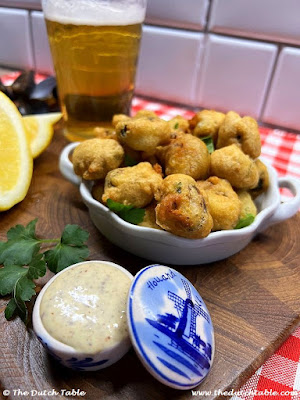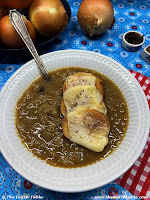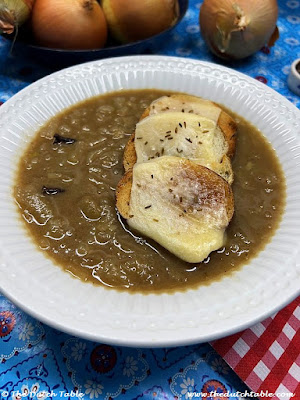But back to the fishmongers' store: here you can find a large variety of fresh fish and seafood, as well as prepared foods. Large platters with a variety of fish, seafood, marinades, and dipping sauces are available for the barbecue (grill) for those summer weekends, or for those gourmet evenings with friends and family. Soft white rolls are stuffed with herring, eel, mackerel, fish paté, or smoked salmon for a bite on the go. They sell shrimp, salmon, herring, or mackerel salads by the portion or by the kilo, for lunch, or for a party. I could go on and on about the amazing foods you can find at the visboer....and most of this is made in-house, and according to traditional recipes.
After cooking up mussels the other day, I was left with about two pounds after dinner: a typical case of eyes bigger than my stomach....but not really, for I had a cunning plan; fried mussels!! These babies are scooped out of their shell, battered, deep-fried, and served with a dipping sauce. Delicious as a snack, with a cold glass of something or other, or served with a fresh spinach stamppot, for example, for dinner: these mussels are very versatile!
If you prepare them from scratch, use this recipe for 2 lbs (1 kg) mussels, but substitute the cup of wine for beer, and cool them after steaming. Two pounds of mussels will give you approximately 8 ounces (225 grams) of meat. If you don't care for beer or wine, you can fish stock or plain water. Use seltzer water for the batter, if you can. You can also often buy already shelled mussel meat in the freezer section.
I used the same mustard dipping sauce that I had for the steamed mussels, but you can also make a remoulade sauce or one of your own liking.
Fried mussels
1/4 cup flour (75 grams)
1/2 cup (100 ml) beer
1 egg
1/2 teaspoon baking powder
1/4 teaspoon salt
1/8 teaspoon paprika powder
1/8 teaspoon chopped garlic
1/4 teaspoon onion powder
4 sprigs fresh parsley, chopped finely (or 1/4 teaspoon dried parsley leaves)
1 lemon
Pat the mussels dry and look for any shell pieces or "beards", small tendrils that are attached to the mussel. Remove. Mix the flour with 3/4 of the beer, the egg, the baking powder, and the rest of the ingredients. Let it sit for five minutes, while you prepare the dipping sauce(s). The batter needs to be thick, like the consistency of thick American pancake batter. If it's thickened too much, add a bit more of the beer and stir.
Heat the fryer to 350F. Set a large platter or a bowl to the side with a few paper towels to soak up the grease. With two spoons, dip each mussel in the batter, and shake off as much batter as you can. Drop them carefully in the hot oil. Fry the morsels golden brown, for about four minutes, and fish them out of the oil, and onto the paper towels.
Slice the lemon in quarters and squeeze over the mussels. Time to dig in!
Serves four.








